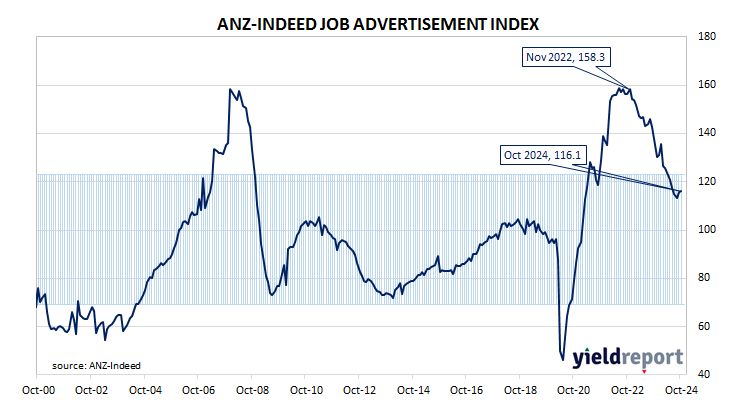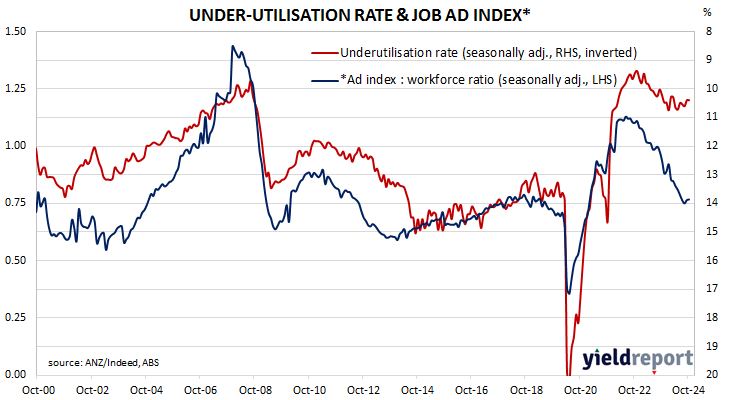Summary: Job ads up 0.3% in October; 15.8% lower than October 2023; ANZ: downward trend in Job Ads may be stabilising; short-term ACGB yields steady, longer-terms yields rise; rate-cut expectations largely unchanged, February cut not especially likely; Indeed: advertisements higher in half of all sectors; ad index-to-workforce ratio increases.
From mid-2017 onwards, year-on-year growth rates in the total number of Australian job advertisements consistently exceeded 10%. That was until mid-2018 when the annual growth rate fell back markedly. 2019 was notable for its reduced employment advertising and this trend continued into the first quarter of 2020. Advertising then plunged in April and May of 2020 as pandemic restrictions took effect but recovered quite quickly, reaching historically-high levels in 2022.
According to the latest reading of the ANZ-Indeed Job Ads Index, total job advertisements in October increased by 0.3% on a seasonally adjusted basis. Their index rose from 115.7 in September after revisions to 116.1, with the gain following a rise of 2.3% in September and a fall of 1.5% in August. On a 12-month basis, total job advertisements were 15.8% lower than in October 2023, up from September’s revised figure of -18.9%.
“ANZ-Indeed Australian Job Ads recorded its second consecutive rise, with the series up 2.6% over the last two months,” said ANZ economist Madeline Dunk. “This suggests the downward trend in Job Ads may be stabilising.”
Short-term Australian Commonwealth Government bond yields finished steady on the day while longer-term yields increased modestly, lagging the upward movements of US Treasury yields on Friday night. By the close of business, the 3-year ACGB yield had returned to its starting point at 4.04%, the 10-year yield had added 2bps to 4.57% while the 20-year yield finished 1bp higher at 4.90%.
Expectations regarding rate cuts in the next twelve months remained largely unchanged, with a February 2025 rate cut not viewed as especially likely. Cash futures contracts implied an average of 4.33% in November, 4.305% in December and 4.26% in February 2025. September 2025 contracts implied 3.915%, 42bps less than the current cash rate.
“Growth in Job Ads in October were Christmas-themed, with both retail and food service opportunities rising considerably,” said Indeed Senior Economist Callam Pickering. “Customer service Job Ads also rose. Over the past three months, Job Ads have increased in half of all sectors, a notable improvement on the widespread declines from earlier this year. This is another sign that Job Ads may be stabilising.”
The inverse relationship between job advertisements and the unemployment rate or the underemployment rate has been quite strong (see below chart), although ANZ themselves called the relationship between the series into question in early 2019.
A higher job advertisement index as a proportion of the labour force is suggestive of lower unemployment rates in the near future while a lower ratio suggests higher unemployment rates will follow. October’s ad index-to-workforce ratio increased from 0.76 to 0.77.
In 2008/2009, advertisements plummeted and Australia’s unemployment rate jumped from 4% to nearly 6% over a period of 15 months. When a more dramatic fall in advertisements took place in April 2020, the unemployment rate responded much more quickly.



